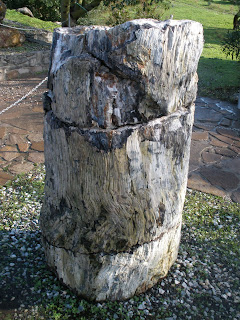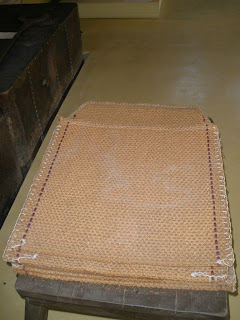My final adventure before departing Lesvos required more planning than the rest: I wanted to see the petrified forest on the west side of the island.
 |
| The yellow dot on the extreme left is the petrified forest at Sigri. The olive farm is one of the 3 dots in the triangular formation in the bottom right. Full size picture here. |
 |
| The forest was 2 hours away and buses run sporadically in the winter, so 2 of us rented a car. Before we saw it, I joked that I would only drive it if it were orange. Wouldn't you know, it almost worked! This is Λεμόνι (Greek for lemon.) |
Car rental is an interesting process in Greece. It involved Dimitris's calling up a rental company the day before, a man's driving Λεμόνι half an hour from Plomari to Perama, Dimitris's driving the man home that night and us into town the next day, and everyone's reversing the process that evening. The actual paperwork, though, was just my showing the man my JOL and signing a piece of paper. When we got back, I handed him €30.
Before we drove off, I spent a solid hour figuring out how the car worked. I was extremely glad I'd had an introduction to standards before leaving the states (thanks Nate! Great birthday present), or I'd never have had the guts to get behind the wheel. Lesvos was not the most gentle introduction, covered as it is with narrow, winding city streets, hairpin turns up steep hills, and little old ladies who seem unaware of the advent of the automobile. But I managed well enough for several towns, until Ronan decided we were unlikely to meet any Greek police (we'd seen no evidence such a creature exists) and took over the rest of the driving.
 |
| The view back toward Perama, looking quite threatening as the sun rose. |
 |
| Random windmill! |
There was a monastery called Λιμονα on the way, so we had to check it out (because, you know, it sounded kind of like the car.)
 |
| We saw a couple of these old sled things on display. They have shards of stone and petrified wood embedded in the bottom for harvesting. |
 |
| Truck full of fish. |
 |
| A military base on the hill beneath an old monastery. (They were failing hard at camouflage.) |
We made it to the Petrified Forest Museum, which was small but really cool. There were chunks of log displayed outside and inside, along with leaf impressions and a helpful historical video translated into English with all the pauses in the wrong place.
 |
| Pine cone impression |
 |
| Behind the museum there were a few petrified stumps still in the ground, with cool, spreading roots. |
 |
| Interesting fort on the coast--we assume it must have been partially restored, but it's not entirely obvious how the bottom blocks were replaced without disturbing the top ones... |














































